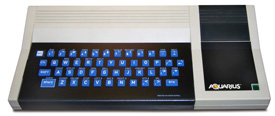Orphaned Computers & Game Systems
(Archive)
Vol. I, Issue 3 December 1994
Mattel Aquarius: Frequently Asked Questions

In 1982, Mattel decided to enter the already crowded home computer market with the Aquarius. The Aquarius was intended to be a home computer and gaming system. Around the same time, Mattel came out with a computer keyboard attachment for the successful home entertainment system, the Intellivision. (I know very little about this system.) [Editor's note: If anyone can provide details about the attachment for the Intellivision, I'll be glad to publish them.]
The Aquarius Features:
Processor: Z80A
Clock Speed: ? MHZ
Internal Ram: 4K (Expandable to 20K)
Internal ROM: 8K
Built In BASIC: A subset of Microsoft BASIC
Video Output: Text Mode: 40 Chars x 24 Lines
Graphics Mode: 80 x 72 pixels (may be higher)
Keyboard: 49 keys, including shift and
control characters
Sound: 1 sound channel (3 with Mini-Expander)
Expansion Slot: For program cartridges and Mini-Expander
Size: 13.5" x 6" x 2"
Released Hardware and Software
Hardware Options:
- Mini-Expander (released): An expansion system that made game-playing easier and more exciting. Came with two detachable, six-key, sixteen-position, disk-based hand controllers (similar to the Intellivision controllers, but with six keys instead of twelve, and no side fire buttons). The unit also added two additional sound channels, and contained two cartridge slots: one for a memory cartridge and the other for a program cartridge.
- Data Recorder (released): A sequential-file, medium-speed cassette player for storing programs and other data.
- Printer (released): A 40-column thermal printer, which had 80 CPS in upper/lowercase text, and 20 graphic lines per second.
- Extra RAM Carts (released): 4K RAM and 20K RAM. (Not released or confirmed: a 32K RAM Cartridge.)
Disks (released):
- LOGO - Allows the user to do graphics programming with Turtle Graphics.
- FinForm - A 63-column x 255-row spreadsheet.
- FileForm - A database/word-processing program.
Cartridges (released):
- Advanced Dungeons & Dragons: Treasures of Tarmin
- Astrosmash
- Biorhythms
- BurgerTime
- Night Stalker
- Reversi
- SNAFU
- Tron: Deadly Disks
- Utopia
Hardware Options:
- Master Expansion Module: A large expansion box with two floppy-disk drives. It allows the use of floppies on the Aquarius, and allows you to boot CP/M.
- MEM Disks (released):
- Extended Microsoft BASIC -- Gives the programmer most if not all of the remaining Microsoft BASIC commands. With this, you can also access the Mini-Expander's controllers (if, for instance, you're writing a game).
- Hints From Heloise -- Was to be a question-and-answer program, with helpful hints for common household problems. Heloise is the author of a popular newspaper column, and an authority on housekeeping.
- MEM Cartridges (released):
- Chess
- Lock 'N Chase
- Sea Battle
Is the Aquarius Public Domain?
Are the Aquarius equipment and software public domain, as with the Vectrex system? This, I don't know yet. In 1984, Mattel was reported to have sold the marketing rights to Radofin Electronics, the producer of the system. I am in the process of trying to find out the status of the Aquarius. If most software was on cartridges, then these would have to have been burnt onto EPROMs in order to be used -- unless someone was able to write a copy program, transfer cartridges to tape or disk, and run the programs from that medium (as with the ADAM).
If you have any information, or find something on this list to be in error, please contact me via e-mail on the Internet at:
ap748@cleaveland.freenet.edu Mail/Phone: Fred Horvat P.O. Box 493 Chesterland, OH 44026 (216) 729-0761